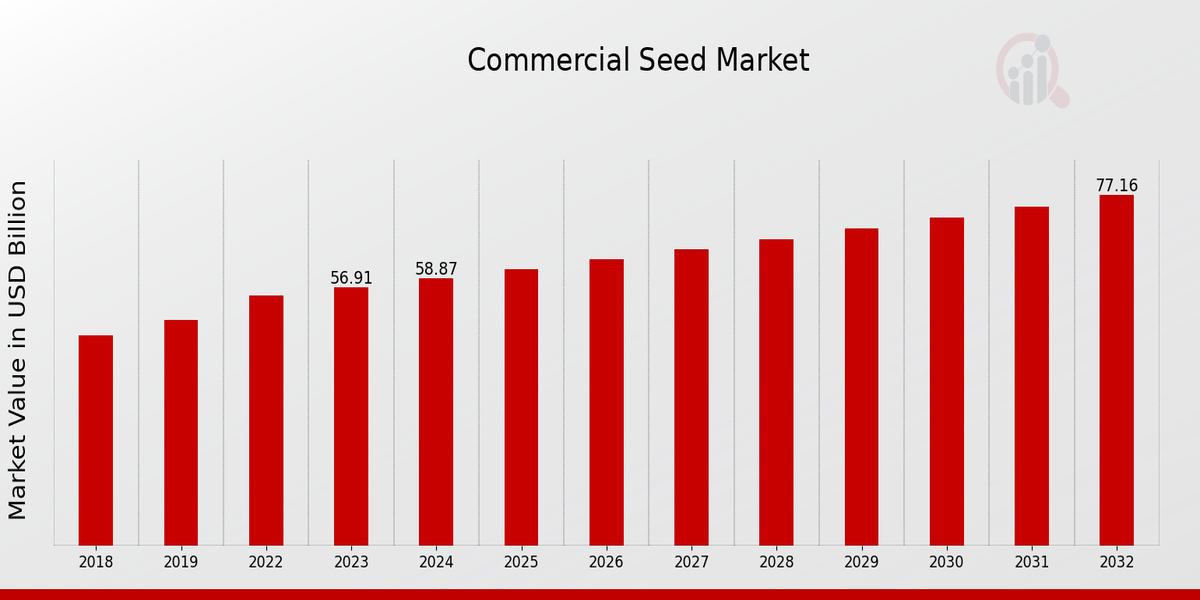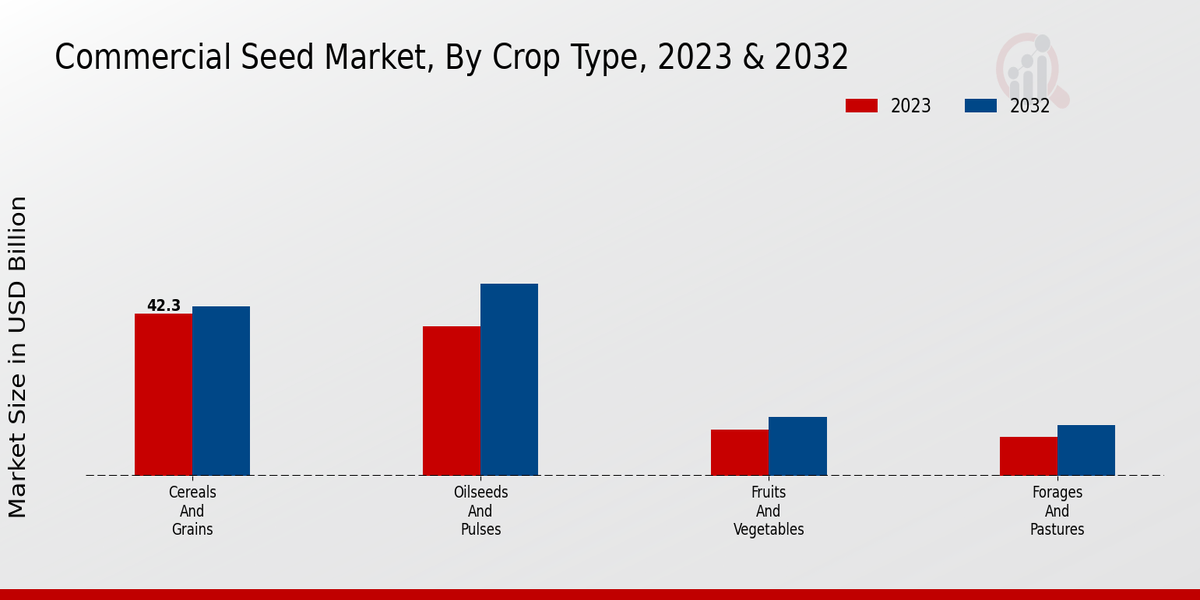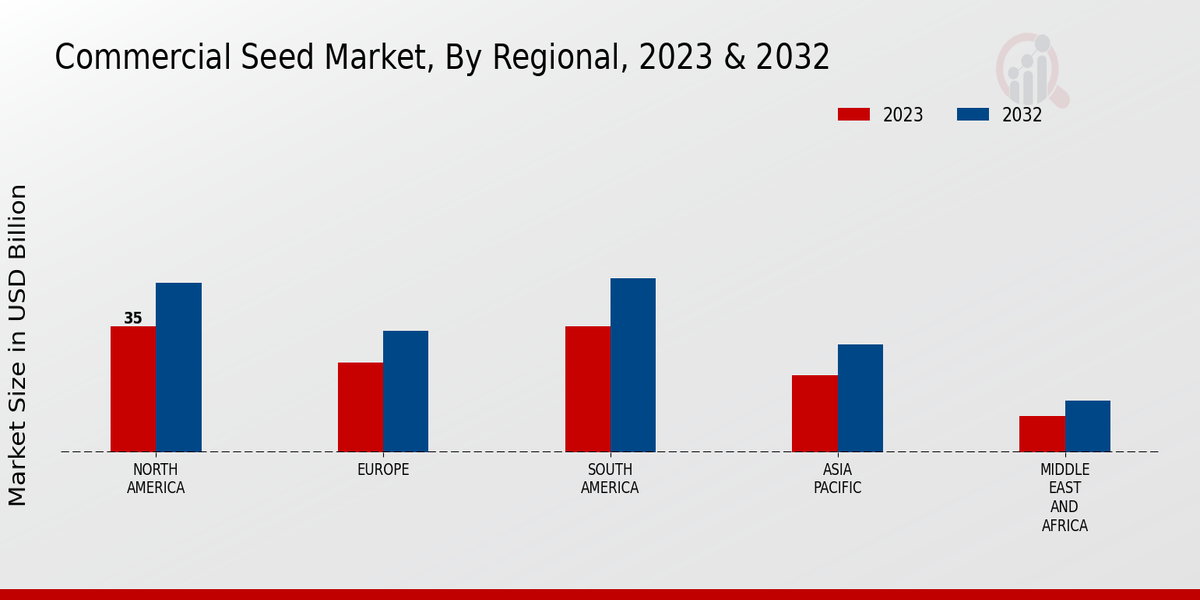Commercial Seed Market Overview
Commercial Seed Market Size was estimated at 55.02 (USD Billion) in 2022. The Commercial Seed Market Industry is expected to grow from 56.91(USD Billion) in 2023 to 77.2 (USD Billion) by 2032. The Commercial Seed Market CAGR (growth rate) is expected to be around 3.44% during the forecast period (2024 - 2032).

Source Primary Research, Secondary Research, MRFR Database and Analyst Review
Key Commercial Seed Market Trends Highlighted
There are various drivers that expand the commercial seed market, such as increasing the productivity of the agriculture sector, increasing the adoption of precision agriculture techniques, etc. In addition, the market is fuelled by government initiatives that seek to enhance sustainable agricultural practices and seed innovation. There is room for further investigation in the areas of creating seeds that can withstand climatic changes, developing customized solutions for the needs of particular crops and using digital approaches for the production and distribution of seeds. Some recent market trends are that seeds are becoming available through e-commerce platforms, data analytics is being implemented in farming to increase productivity, and seed companies are becoming more and more interested in protecting their intellectual properties.
Commercial Seed Market Drivers
Increasing Demand for Sustainable Farming Practices
The growing awareness of the environmental impact of conventional farming practices is driving the demand for sustainable alternatives. Commercial seeds offer a number of benefits in this regard, including improved crop yields, reduced water and fertilizer requirements, and increased resistance to pests and diseases. These factors are expected to continue to drive the growth of the Commercial Seed Market Industry in the coming years.
Expansion of the Agriculture Industry
The population is increasing at an accelerated rate, and as such, our world’s food supply is becoming overwhelmed. Farmers all over the world are increasingly turning to commercial seeds as a way to satisfy this exponentially increasing demand for food. The recent switch towards commercial seeds is logical, as they are genetically bred to be more resistant to disease and pests – with many of them also producing higher yields than the traditional alternatives.
Government Support for Commercial Seed Development
Governments around the world are increasingly recognizing the importance of commercial seeds for food security. As a result, they are providing financial support for the research and development of new commercial seed varieties. This support is expected to continue in the coming years, which will help to accelerate the growth of the Commercial Seed Market Industry.
Commercial Seed Market Segment Insights
Commercial Seed Market Crop Type Insights
The Commercial Seed Market is segmented by Crop Type into Cereals and Grains, Oilseeds and Pulses, Fruits and Vegetables, and Forages and Pastures. Among these segments, Cereals and Grains held the largest market share of 42.3% in 2023 and is expected to continue dominating the market throughout the forecast period. The growth of this segment can be attributed to the increasing demand for staple food crops such as rice, wheat, and corn. Oilseeds and Pulses segment is projected to witness the fastest growth over the forecast period, with a CAGR of 4.2%.
This growth is driven by the rising demand for plant-based proteins and the increasing use of oilseeds in the production of biofuels. The Fruits and Vegetables segment is expected to account for a significant share of the Commercial Seed Market revenue by 2032. The growing awareness of healthy eating habits and the increasing demand for fresh produce are key factors contributing to the growth of this segment. The Forages and Pastures segment is expected to hold a steady market share over the forecast period. The demand for forages and pastures is primarily driven by the growing livestock population and the need for high-quality feed.
Overall, the Commercial Seed Market is expected to witness significant growth over the forecast period, driven by factors such as increasing population, rising demand for food, and the adoption of advanced agricultural technologies.

Source Primary Research, Secondary Research, MRFR Database and Analyst Review
Commercial Seed Market Seed Treatment Insights
The seed treatment segment is expected to witness significant growth in the Commercial Seed Market, projected to reach a valuation of USD 12.6 billion by 2027, exhibiting a CAGR of 4.6% during the forecast period. Untreated seeds refer to raw seeds that have not undergone any treatment processes. Treated seeds, on the other hand, have been subjected to various treatments, such as coating or inoculation, to enhance their performance and protect them from pests and diseases. The growing demand for treated seeds is attributed to factors such as increased crop yields, reduced disease incidence, and improved plant vigor.
Additionally, the adoption of precision farming practices, which involve the use of data-driven technologies to optimize crop production, is further fueling the demand for treated seeds.
Commercial Seed Market Distribution Channel Insights
The distribution channel segment plays a crucial role in the Commercial Seed Market. Distributors/wholesalers are responsible for distributing seeds to retailers and farmers, while retail stores sell seeds directly to consumers. E-commerce platforms have emerged as a significant distribution channel, offering convenience and a wide selection of seeds. In 2023, the Commercial Seed Market revenue through distributors/wholesalers was valued at USD 25.4 billion, while retail stores and e-commerce accounted for USD 18.3 billion and USD 13.2 billion, respectively.
Commercial Seed Market Seed Production Method Insights
Seed Production Method Segment Overview The commercial seed market can be segmented based on seed production method into conventional seeds, genetically modified seeds, and hybrid seeds. Conventional seeds are produced through natural pollination methods, without any genetic modification. Genetically modified seeds, on the other hand, are produced using genetic engineering techniques to introduce specific traits or characteristics into the seed. Hybrid seeds are a cross between two different varieties of plants, resulting in offspring with improved traits.
In 2023, the conventional seeds segment accounted for the largest share of the commercial seed market, with a revenue of USD 35.61 billion. This segment is expected to continue to dominate the market over the forecast period, owing to the widespread adoption of conventional farming practices, particularly in developing countries. However, the genetically modified seeds segment is expected to grow at a faster rate, driven by increasing demand for crops with improved yield, resistance to pests and diseases, and tolerance to environmental stresses.
The hybrid seeds segment is also expected to witness significant growth, as farmers seek to improve crop yield and quality through the use of hybrid varieties.
Commercial Seed Market Regional Insights
The Commercial Seed Market is segmented into regions, namely, North America, Europe, APAC, South America, and MEA. Among these, North America held the largest market share in 2023, accounting for around 35% of the Commercial Seed Market revenue. The region's dominance can be attributed to the presence of major seed companies, advanced agricultural practices, and a large consumer base. Europe is another significant region in the Commercial Seed Market, with a market share of approximately 25%. The region's strong agricultural sector and government support for sustainable farming practices drive growth in this market.
The APAC region is expected to witness substantial growth in the coming years, owing to the increasing demand for food and the adoption of modern agricultural technologies. South America and MEA also contribute to the Commercial Seed Market, with MEA expected to show promising growth potential in the future.

Source Primary Research, Secondary Research, MRFR Database and Analyst Review
Commercial Seed Market Key Players And Competitive Insights
Major players in the Commercial Seed Market are actively involved in strategic collaborations, mergers, and acquisitions to expand their market presence. Leading Commercial Seed Market players are focusing on research and development activities to introduce innovative products and technologies. The Commercial Seed Market industry is characterized by intense competition, with key players vying for market share through product differentiation and competitive pricing. Commercial Seed Market development is influenced by factors such as technological advancements, changing consumer preferences, and evolving regulatory landscapes.
Bayer AG, the leading player in the Commercial Seed Market, has a strong presence and a diverse portfolio of seed products. The company's research and development capabilities have enabled it to develop high-yielding and disease-resistant varieties of seeds. Bayer AG's extensive distribution network and strong brand recognition contribute to its competitive advantage.
Another major player in the Commercial Seed Market is Corteva Agriscience, a leading provider of seed, crop protection, and digital agriculture solutions. Corteva Agriscience has a broad product portfolio that includes corn, soybean, wheat, and cotton seeds. The company's focus on sustainability and innovation has enabled it to develop environmentally friendly and high-performing seed varieties. Corteva Agriscience's commitment to research and development, combined with its reach, has positioned it as a key competitor in the Commercial Seed Market.
Key Companies in the Commercial Seed Market Include
Commercial Seed Market Industry Developments
The Commercial Seed Market is projected to reach USD 77.2 billion by 2032, exhibiting a CAGR of 3.44% during the forecast period (2024-2032). The growing demand for high-quality and productive seeds in agriculture, coupled with the increasing adoption of advanced farming practices, is driving market growth.
Recent news and developments in the market include
In January 2023, Bayer Crop Science announced the development of a new corn seed variety with improved drought tolerance and yield potential.
In March 2024, Syngenta launched a new line of non-GMO soybean seeds with enhanced disease resistance and nutritional value.
In July 2024, the United Nations Food and Agriculture Organization (FAO) launched a new initiative to promote the use of improved seeds in developing countries.
These developments indicate the growing importance of commercial seeds in ensuring food security and meeting the challenges of climate change.
Commercial Seed Market Segmentation Insights
Commercial Seed Market Crop Type Outlook
Cereals and Grains
Oilseeds and Pulses
Fruits and Vegetables
Forages and Pastures
Commercial Seed Market Seed Treatment Outlook
Untreated Seeds
Treated Seeds (e.g., coated, inoculated)
Commercial Seed Market Distribution Channel Outlook
Distributors/Wholesalers
Retail Stores
E-commerce
Commercial Seed Market Seed Production Method Outlook
Conventional Seeds
Genetically Modified Seeds
Hybrid Seeds
Commercial Seed Market Regional Outlook
North America
Europe
South America
Asia Pacific
Middle East and Africa
| Report Attribute/Metric |
Details |
| Market Size 2022 |
55.02(USD Billion) |
| Market Size 2023 |
56.91(USD Billion) |
| Market Size 2032 |
77.2(USD Billion) |
| Compound Annual Growth Rate (CAGR) |
3.44% (2024 - 2032) |
| Report Coverage |
Revenue Forecast, Competitive Landscape, Growth Factors, and Trends |
| Base Year |
2023 |
| Market Forecast Period |
2024 - 2032 |
| Historical Data |
2019 - 2023 |
| Market Forecast Units |
USD Billion |
| Key Companies Profiled |
Takii Co., Ltd., Beijing Dabeinong Technology Group Co., Ltd, Land O'Lakes, Sakata Seed Corporation, Secobra Group, Bayer, Syngenta Group, KWS SAAT SE Co. KGaA, Groupe Roullier, BASF, Nongwoo Bio Co., Ltd., Corteva Agriscience, Limagrain |
| Segments Covered |
Crop Type, Seed Treatment, Distribution Channel, Seed Production Method, Regional |
| Key Market Opportunities |
Increasing demand for hybrid seeds Growing adoption of precision farming Expansion into emerging markets Rising awareness of seed quality Technological advancements in seed breeding |
| Key Market Dynamics |
Rising demand for genetically modified seeds, increasing acreage for commercial cultivation, government initiatives promoting agriculture advancements in seed technology and growing awareness about seed quality |
| Countries Covered |
North America, Europe, APAC, South America, MEA |
Frequently Asked Questions (FAQ) :
The Commercial Seed Market is expected to reach an overall valuation of approximately USD 56.91 billion in 2023.
The Commercial Seed Market is projected to grow at a CAGR of 3.44% from 2024 to 2032.
By 2032, the overall valuation of the Commercial Seed Market is expected to reach approximately USD 77.2 billion.
The North America region is projected to hold a significant market share in the Commercial Seed Market due to factors such as increasing agricultural productivity and growing demand for high-quality seeds.
Commercial seeds are primarily used for various applications, including field crops, vegetable production, and forage crops.
Major players in the Commercial Seed Market include Bayer CropScience, Corteva Agriscience, and Syngenta.
Factors such as the rising population, increasing demand for food, and advancements in seed technology are driving the growth of the Commercial Seed Market.
Challenges in the Commercial Seed Market include climate change, seed piracy, and the emergence of pests and diseases.
Trends such as the adoption of precision agriculture, the development of genetically modified seeds, and the increasing use of data analytics are shaping the Commercial Seed Market.
Emerging technologies such as artificial intelligence, blockchain, and gene editing have the potential to revolutionize the Commercial Seed Market by improving seed quality, optimizing crop yields, and enhancing traceability.

















